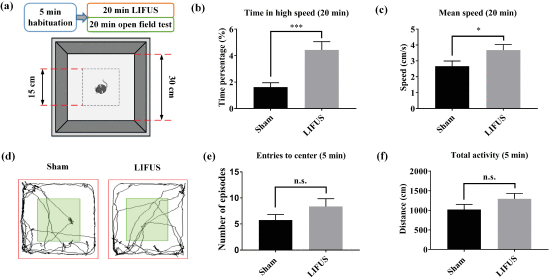


Yibo Wang, Lili Niu, Wen Meng, Zhengrong Lin, Junjie Zou, Tianyuan Bian, Xiaowei Huang, Hui Zhou, Long Meng*, Ping Xie*, Hairong Zheng*.
Low-intensity focused ultrasound stimulation (LIFUS) has the potential to noninvasively penetrate the intact skull and to modulate neural activity in the cortex and deep brain nuclei. The midbrain periaqueductal gray (PAG) is associated with the generation of defensive behaviors. The aim of this study was to examine whether LIFUS of the PAG induced defensive behaviors in mice. A 3.8-MHz head-mounted ultrasound transducer with a small focus size (0.5 mm × 0.5 mm) was fabricated in house to precisely stimulate the free-moving mice. The corresponding behaviors were recorded in real time. Avoidance, flight, and freezing were used to assess ultrasound-induced defensive responses. The safety of LIFUS was examined via hematoxylin and eosin (H&E) staining and Nissl staining. Ultrasound stimulation of the PAG induced multiple defensive behaviors, including location-specific passive avoidance behavior, flight, and freezing. In addition, H&E and Nissl staining verified that LIFUS did not cause any injury to the brain tissue. These findings demonstrate that LIFUS may have neuromodulatory effects on the innate defensive behaviors in mice. LIFUS may be used as a novel neuromodulatory tool for the treatment of psychological diseases associated with defensive behaviors.
低强度聚焦超声波刺激(LIFUS)可以无创穿透完整的头骨,调节大脑皮层和深层脑核的神经活动。中脑会厌灰质(PAG)与防御行为的产生有关。本研究的目的是检测 PAG 的 LIFUS 是否会诱发小鼠的防御行为。研究人员自制了一个3.8兆赫的头戴式超声换能器,其焦点尺寸很小(0.5毫米 × 0.5毫米),可精确刺激自由移动的小鼠。相应的行为被实时记录下来。用回避、逃跑和冻结来评估超声诱导的防御反应。LIFUS的安全性通过苏木精和伊红(H&E)染色以及Nissl染色进行检验。对PAG的超声波刺激诱发了多种防御行为,包括特定位置的被动回避行为、逃跑和冻结。此外,H&E和Nissl染色证实LIFUS不会对脑组织造成任何损伤。这些研究结果表明,LIFUS可能对小鼠的先天防御行为具有神经调节作用。LIFUS可作为一种新型神经调节工具,用于治疗与防御行为相关的心理疾病。